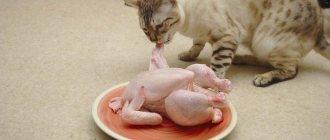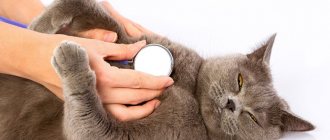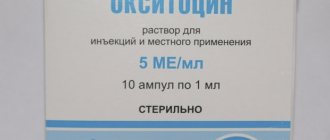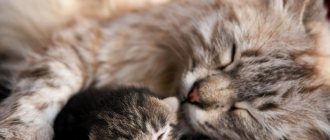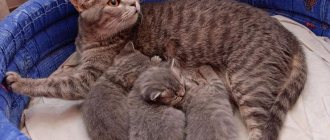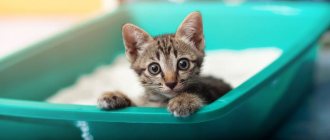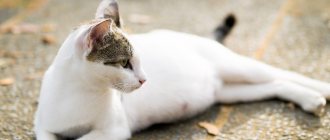“Soft paws - in the paws of a scratchy paw” is a well-known children's riddle about a cat, a beloved pet by many. Sometimes, for some reason, these very scratches (cat's claws) can injure the soft tissues of the paw. This happens when defective ingrown claws grow, which threaten the development of complications in the cat.
What causes a claw to grow into the paw pad?
Nature has thought of everything: to prevent claws from curling and growing into the skin, cats sharpen their claws on their own. Street cats do this in yards: the claws on their front paws are worn down on tree trunks, and the claws on their back paws are worn down while walking. Domestic cats have found another way out: they sharpen their claws on door frames or wallpaper. The owners do not like this situation, so many buy a scratching post - a special device for sharpening claws. A cat's claw should not reach the pad of its paw. There are several reasons why claws can grow to large sizes, bend and grow in:
- the cat moves little;
- sharpens claws poorly;
- hereditary and genetic predisposition.
An adult cat's body may lack vitamins and minerals. This leads to impaired growth of the claws and curvature of the claw plate. Statistically, older cats are more likely to have ingrown claws than young cats. Claws grow into the footpad due to injuries during play or a fall from a height: deformation or change in the length of the claw occurs.
What are the symptoms of ingrown claws?
In general, a cat owner can easily determine that a cat has an ingrown claw. The cat's pads and toes may swell, she will constantly chew, bite, and lick her paws, and there will be severe sensitivity if you touch her paw. The cat may also limp, the pad may bleed, and the cat may even become depressed because its paw hurts. Also, the cat may refuse to perform various actions in order for its paw to rest. The cat will also have detached behavior, for example, the cat often hisses in pain. If you notice these symptoms and, after examining your paw, find an ingrown claw, you need to contact your veterinarian.
How to tell if a cat has an ingrown claw
The owner will independently determine this problem based on the following symptoms :
- the cat refuses outdoor games, runs and jumps less;
- The pet is limping and carefully steps on its sore paw. When walking, an ingrown claw injures soft tissues, creates pain and discomfort;
- the cat pays more attention to the injured leg: licks the paw pad, tries to bite off the claw;
- at the site of ingrowth, the skin swells, turns red and becomes inflamed.
Stages of an ingrown toenail
There are 3 main stages of the disease, which are characterized by the following symptoms:
- Stage 1
: Moderate pain, slight swelling and pressure in the finger. - Stage 2
: Severe swelling, suppuration, throbbing pain, the nail plate thickens and becomes dull, deformation and enlargement of the nail fold are observed. The wound becomes infected and an inflammatory process occurs. - Stage 3
: The disease enters a chronic stage in which proliferation of granulation tissue and deformation of the nail fold and plate are observed. In this case, even bone tissue can become inflamed.
The higher the stage of the disease, the more difficult and lengthy the treatment. Therefore, at the first symptoms you should immediately consult a doctor. Ingrown toenails are especially dangerous for people with diabetes.
How to cure at home
Not many people know about ways to help a pet in this situation. Do not straighten the claw or pull it out manually. This can cause harm. Take special nail clippers. Every owner should have them. Before the procedure, you need to disinfect them. Alcohol, vodka or chlorhexidine will do. Treat the area where the claw is ingrown with an antiseptic. Hold your paw firmly to prevent the cat from twitching. It's good if you have an assistant. He will fix the animal, you will carry out the procedure. Use pliers to cut off the ingrown claw down to the pink part. Blood vessels pass through there and should not be damaged. After trimming, the ingrown claw is pulled out with a sharp movement using tweezers or nippers. The procedure is painful, the animal will struggle. Therefore, it is important to do everything quickly. The cut claw is easily removed. Does not injure neighboring tissues.
Treat the wound with an antiseptic to disinfect and prevent infection. You can use furatsilin or hydrogen peroxide. Lubricate the removal site with antibacterial ointment. Cut off the rest of the claw as much as possible so that it does not touch the paw pad.
The procedure can be carried out at home in the absence of infection and inflammation of the wound. If there is redness and swelling on the soft tissues, contact your veterinarian.
Breaking off a claw
Claw breaking in cats most often occurs due to abnormal growth of claws, injury, or lack of proper care for the claws of a furry pet. If a cat does not have the opportunity to grind down its claws, they constantly grow. The fabric becomes thinner, and any, even minor, mechanical impact can lead to breaking off the nail.
Symptoms
As a rule, in cats, the sharp part of the claw breaks off or the nail at its base breaks. Symptoms of such a defect can be seen with the naked eye.
Among the main manifestations are:
- restless behavior;
- inactivity;
- bleeding at the base of the claw;
- pain on palpation.
Treatment
If a cat's nail is broken, treatment is carried out at home, if there is no inflammation, or in a veterinary clinic. If the nail is broken but not torn off, use scissors or forceps to cut off the damaged part. Treat the injury site with hydrogen peroxide or any other antiseptic. File the tip with a file to avoid injury to soft tissues.
If the claw is severely damaged and there is noticeable bleeding, bandage the paw and take the cat to the clinic.
Help from a veterinarian
The veterinary clinic will help in the most severe cases: when the wound becomes infected and the claw grows deep into the paw. The doctor will conduct an examination. Assess the complexity of the case, the degree of claw ingrowth and the need for surgical intervention.
If the claw is not deeply ingrown and there is no inflammation, the veterinarian will remove the claw using special tools. The wound will be treated with an antiseptic to avoid inflammation. If the wound festers, a decision is made to operate. It is performed under local anesthesia. The place of suppuration is opened, the pus and the ingrown claw are removed. The wound is disinfected.
In severe cases, the operation is performed under general anesthesia. A small incision is made at the site where the claw grows in. The claw is cut off and carefully removed. The accumulated pus is cleaned out. The wound is treated with an antiseptic solution. At the end, a sterile bandage is applied.
Diagnosis of onychocryptosis
Diagnosis of ingrown toenail disease may include the following steps:
- The doctor listens to the patient's complaints.
- The surgeon visually examines a finger with an ingrown nail, identifying the underlying disease and associated diseases, such as fungus.
- When the inflammatory process begins, the doctor prescribes tests:
- general analysis to determine the degree of the inflammatory process;
- blood glucose test to determine diabetes mellitus;
- culture of purulent discharge to determine the type of infection.
- The doctor prescribes an x-ray of the foot, which will determine the size and shape of the nail growth, damage to bone structures and the area of suppuration.
After diagnosis, the doctor prescribes treatment, which depends on the stage of the disease.
Postoperative care
Immediately after removing an ingrown nail, your veterinarian may prescribe antibiotics. They should be taken immediately to avoid the inflammatory process. Additionally, it is recommended to give your pet a complex of minerals and vitamins. In order for injured tissue to quickly recover and heal, immunomodulators are prescribed.
To avoid getting an infection in your foot, wash your floors more often. The room where the pet lives must be clean. Walking and active games are temporarily contraindicated for cats. It is necessary to keep the paw at rest until it has fully recovered.
Onychocryptosis
The disease of ingrown toenails is called onychocryptosis. Most often, the nail grows into the nail fold on the outside of the big toe. With onychocryptosis, the finger around the nail plate becomes red, swollen and begins to hurt. If such symptoms do not promptly consult a doctor, then a chronic inflammatory process may develop. Ingrown toenails are a common condition that anyone can experience. In addition, it is not recommended to self-medicate, since improper treatment may result in recurrence of the disease.
Both children and adults suffer from onychocryptosis, but ingrown toenails are more common in young people of working age. Onychocryptosis occurs in 10% of the working population.
Prevention methods
To prevent the claw from growing into the paw pad, veterinarians recommend following simple recommendations:
- create conditions for natural grinding of claws. Allow the pet to sharpen its claws to the required height;
- For cats with a genetic predisposition to ingrown and deformed claws, have multiple nail trimming procedures performed at your veterinary clinic. This will straighten the shape of the claw plate and prevent it from growing into the paw;
- If you do not practice walking your cat outside, purchase a high-quality nail clipper. Trim the nails regularly and then carefully file down the edges;
- Inspect your pet's paws as often as possible to identify ingrown claws and other defects. If a problem is detected at an early stage, the claw can be removed without surgery, healing will be faster and easier;
- Protect the animal from injuries to limbs and falls from great heights. This is necessary to prevent deformation and change in the size of the claw.
Remember! If the situation of a claw growing into a paw has already happened, it may happen again. Therefore, carefully monitor your pet.
It is important for owners to know that the most problematic claw is the claw on the fifth toe of the front paws. Anatomically, it is located on the back side above the rest of the cat's fingers. He is actively growing, nothing bothers him. Due to its location, this claw does not reach the surface on which cats grind their claws. Therefore, it is most often the one that grows into soft tissues. The problem of ingrown claws is a common pathology in cats and dogs. It is important to regularly inspect your pet's paws and follow the prevention recommendations above. If you notice an ingrown claw, contact a veterinary clinic as soon as possible. This will help avoid complications. The extraction procedure will be less painful and complicated. No surgery or long recovery period is required.
Trim your nails regularly to protect yourself and your pet from unnecessary problems.
Why is there a problem?
Veterinarians warn owners of elderly pets that ingrown nails and subsequent inflammation are more common in mature cats than in young cats. This phenomenon is associated with a lack of vitamins and beneficial microelements.
Nail-related disorders are often reported in pets. In some cats, the claw may simply be turned in the opposite direction; in others, it comes off completely. The problem is a consequence of the active lifestyle of the feline family, which often climb trees or sharpen their nails on furniture. Normally, the pad and nail plate of cats should not touch. When the claws grow quickly and become rough, the following factors can affect this:
- insufficiently active lifestyle;
- improper grinding of nails;
- mechanical damage, in which the owner notices that the cat has injured either a claw or it has completely come off;
- predisposition to pathology at the genetic level.
Complications
With an advanced stage of an ingrown toenail and improper treatment, the following complications may occur:
- Gangrene of the finger is a serious complication in which tissue necrosis occurs. The only way out is complete removal of dead tissue - amputation of the finger.
- Inflammation of the soft tissues of the entire finger with the development of a purulent process, which requires immediate clinical treatment.
- The appearance of tumors requiring surgical removal.
- Purulent inflammation of the bones of the finger, requiring immediate conservative and surgical treatment.
- Other complications delaying the recovery process.
All complications of an ingrown toenail can lead to even more serious consequences if you do not consult a doctor in time. At the first symptoms of onychocryptosis, you should consult a doctor as soon as possible in order to avoid complications and longer treatment. The sooner you start treating an ingrown toenail, the faster and easier this process will be.
Treatment of ingrown toenails
Treatment of onychocryptosis can be carried out by surgical and non-surgical methods, but more often the treatment consists of a combination of these two treatment methods.
Surgical treatment of onychocryptosis
The operation is performed under local anesthesia, in which pain relief is administered with a syringe into the finger. After 10 - 15 minutes, after the anesthetic has taken effect, the surgeon begins the operation.
The following tools and excision methods are used to remove an ingrown toenail:
- A scalpel
is a traditional tool for removing ingrown toenails. - Surgical laser
is the most preferred method of excision of ingrown toenails, allowing to minimize trauma, reduce recovery time and reduce the likelihood of relapses. The laser is very thin and at the same time additionally disinfects the excision area. - Radio wave method
- allows radio waves to evaporate the ingrown part of the nail. The method is preferable, as it causes little damage to areas of healthy skin and allows for faster recovery.
In our clinic, we mainly use the laser method of removing ingrown toenails as the most effective.
There are 4 main surgical operations used to remove an ingrown toenail:
- Complete removal of the nail plate
, which is used in very rare cases with advanced disease. After surgery, surgical stitches are placed on the finger. After such an operation, relapse is possible. - Marginal resection of the nail plate with resection of the periungual fold
. It is used at stages 2 and 3 of the disease. After surgery, sutures are placed on the periungual fold. - Marginal resection of the nail plate without resection of the periungual fold
. Used at an early stage of the disease. In this case, up to 2 millimeters of the nail plate is removed with the destruction of the germ layer. - Destruction of the nail growth zone with a laser
. Used in conjunction with other methods of removing ingrown toenails to reduce the likelihood of recurrence.
After removing the ingrown part of the nail, the doctor prescribes conservative treatment for successful recovery and reducing the likelihood of reoccurrence of onychocryptosis.
Non-surgical treatment of onychocryptosis
After surgery, to care for your finger, your doctor may prescribe:
- reducing or eliminating running, walking and working;
- taking anti-inflammatory drugs;
- timely dressing of the finger;
- compresses;
- disinfectant baths;
- use of ointments.
In order to prevent relapses, for a long time the surgeon may recommend:
- wearing loose shoes that do not put pressure on the toe;
- regular and correct trimming of nails, implying the absence of a hangnail on the nail and the formation of a nail plate of the desired size;
- losing weight to reduce the load on the finger;
- maintaining hygiene.
In addition, to treat an ingrown toenail, the doctor can use corrective staples-plates.
Using a corrective plate bracket on the nail
This is a method of conservative treatment of ingrown toenails using staples and plates that are inserted between the nail and the skin and correct the direction of growth of the nail plate. These devices allow you to straighten the nail and eliminate the occurrence of onychocryptosis.
The most common staples and plates are:
- Bracket 3-TO
. It consists of 2 hooks that are attached to the edges of the nail and a loop that tightens the hooks that guide the growth of the nail. It is used for ingrown or curled nails after injuries, calluses and relapses. Use with extreme caution in patients with diabetes. - Combiped bracket
. Attaches to the nail, straightening and straightening it. Can be used for unilateral ingrown nails. In this case, one of the staples is placed over the edge of the nail plate, and the other is combined with a plastic pad that is glued to the nail. Used for ingrown, deformed and curled nail plates. Use with extreme caution in patients with diabetes. May be contraindicated for patients who are allergic to the staple material. - Fraser bracket
. The hooks of the staple are inserted over the edges of the nail and the staple is tightened, and as the nail straightens, the tension force of the staple is reduced. It is used for ingrown and curled nails after injuries and relapses. May be contraindicated in case of fungus, discharge of blood and pus, as well as psoriasis. - Podofix plate
. It is installed with glue on the nail plate, and the tension force of the Podofix device is regulated by a special wire. used for ingrowth, curling and deformation of the nail against the background of core calluses and hypergranulation. Use with extreme caution in patients with diabetes. - B/S plate
. Installed on a pre-treated nail using glue. Used to correct ingrown toenails. Use with extreme caution in patients with diabetes.
Treatment of ingrown toenails with staples and plates is painless. This method allows you to achieve recovery with a high probability without relapse.
Treatment of onychocryptosis with folk remedies
Among those suffering from onychocryptosis, there is a high demand for treating ingrown toenails with folk remedies at home. But such treatment is ineffective and can only help as part of complex professional therapy. An ingrown toenail cannot be treated on your own, as there is a high risk of misassessing the situation, triggering and aggravating the disease.
If a symptom of onychocpriptosis appears, you should always consult a doctor - a surgeon or podiatrist. And if a medical specialist recommends something from folk remedies for a successful recovery, then in this case they can be used.
Folk remedies for treating ingrown toenails include:
- Lotion with a cotton pad on the wound with agents that have antiseptic and soothing properties:
- kombucha;
- aloe;
- essential oils (tea tree, fir, plantain, sea buckthorn).
- Ointments based on calendula or aloe.
- Baths with medicinal herbs, soda and salt, essential oils, iodine or potassium permanganate.
- Compresses, for example with laundry soap and fat or onions.
- Cotton swabs under the nail, soaked in sea salt, soda, lemon juice, essential oils or medicinal herbs.
And remember that folk remedies do not guarantee recovery, and in some cases, in the absence of timely treatment from a doctor, they can cause harm and worsen the course of the disease.
